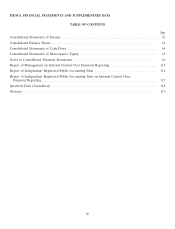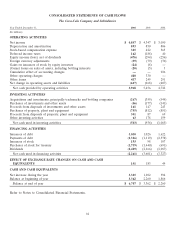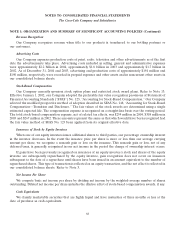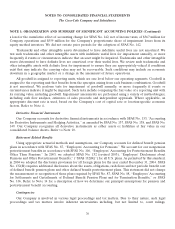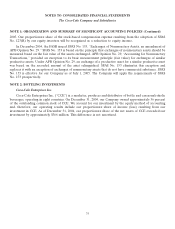Coca Cola 2004 Annual Report Download - page 69
Download and view the complete annual report
Please find page 69 of the 2004 Coca Cola annual report below. You can navigate through the pages in the report by either clicking on the pages listed below, or by using the keyword search tool below to find specific information within the annual report.NOTES TO CONSOLIDATED FINANCIAL STATEMENTS
The Coca-Cola Company and Subsidiaries
NOTE 1: ORGANIZATION AND SUMMARY OF SIGNIFICANT ACCOUNTING POLICIES (Continued)
to the economic risks and potential rewards from the variable interest entity’s assets and activities are the best
evidence of control. If an enterprise holds a majority of the variable interests of an entity, it would be considered
the primary beneficiary. Upon consolidation, the primary beneficiary is generally required to include assets,
liabilities and noncontrolling interests at fair value and subsequently account for the variable interest as if it were
consolidated based on majority voting interest.
In our financial statements as of December 31, 2003 and prior to December 31, 2003, we consolidated all
entities that we controlled by ownership of a majority of voting interests. As a result of Interpretation 46,
effective as of March 31, 2004, our consolidated balance sheet includes the assets and liabilities of:
• all entities in which the Company has ownership of a majority of voting interests; and additionally,
• all variable interest entities for which we are the primary beneficiary.
Our Company holds interests in certain entities, primarily bottlers, previously accounted for under the
equity method of accounting that are considered variable interest entities. These variable interests relate to
profit guarantees or subordinated financial support for these entities. Upon adoption of Interpretation 46 as of
March 31, 2004, we consolidated assets of approximately $383 million and liabilities of approximately
$383 million that were previously not recorded on our consolidated balance sheet. We did not record a
cumulative effect of an accounting change, and prior periods were not restated. The results of operations of
these variable interest entities were included in our consolidated results beginning April 1, 2004 and did not have
a material impact for the year ended December 31, 2004. Our Company’s investment, plus any loans and
guarantees, related to these variable interest entities totaled approximately $313 million at December 31, 2004,
representing our maximum exposure to loss. Any creditors of the variable interest entities do not have recourse
against the general credit of the Company as a result of including these variable interest entities in our
consolidated financial statements.
Use of Estimates and Assumptions
The preparation of our consolidated financial statements requires us to make estimates and assumptions
that affect the reported amounts of assets, liabilities, revenues and expenses and the disclosure of contingent
assets and liabilities in our consolidated financial statements and accompanying notes. Although these estimates
are based on our knowledge of current events and actions we may undertake in the future, actual results may
ultimately differ from estimates and assumptions.
Risks and Uncertainties
The Company’s operations could be adversely affected by restrictions on imports and exports and sources of
supply; prolonged labor strikes (including any at key manufacturing operations); adverse weather conditions;
advertising effectiveness; changes in labeling requirements; duties or tariffs; changes in governmental
regulations; the introduction of additional measures to control inflation; changes in the rate or method of
taxation; the imposition of additional restrictions on currency conversion and remittances abroad; the
expropriation of private enterprise; or product issues such as a product recall. In addition, policy concerns
particular to the United States with respect to a country in which the Company has operations could adversely
affect our operations. The foregoing list of risks and uncertainties is not exclusive.
Our Company monitors our operations with a view to minimizing the impact to our overall business that
could arise as a result of the risks inherent in our business.
67





